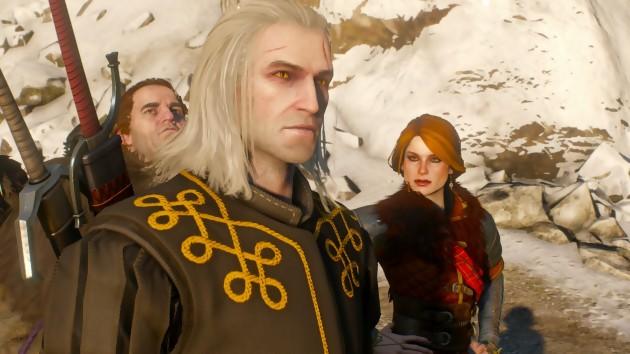 This third installment in the CD Projekt saga is a kind of immense "Perdu de vue", with Geralt both in the role of the guest and that of Jacques Pradel. It is possible that the youngest have not completely grasped the reference but at least it will perhaps encourage them to discover a TV program that exudes the joy of living. Following directly in the footsteps of the second opus, it therefore places our witcher, who has finally regained his memory, at the heart of the conflict between the Northern Kingdoms, united by force under the banner of Redania, and the empire of Nilfgaard. In the midst of all this, Geralt finally dedicates himself to his little person and goes in search of the magician Yennefer, his pre-amnesiac love, just to pick up the pieces of his past. But very quickly (and without spoiling you too much), the attention of our hero will have to change target. By order of the Emperor of Nilfgaard, Emhyr var Emreis, and also because he feels like it, Geralt will have to get his hands on Ciri, his adopted daughter, whom he raised within the walls of Kaer Morhen. She had been forced to disappear years earlier to spare her mentor from the pangs of power that runs through her veins; a power now coveted by the specters of the Wild Hunt, who seem determined to burn everything down if they can get a hold of him. It's concise, but we've chosen to let you discover all this for yourselves.
This third installment in the CD Projekt saga is a kind of immense "Perdu de vue", with Geralt both in the role of the guest and that of Jacques Pradel. It is possible that the youngest have not completely grasped the reference but at least it will perhaps encourage them to discover a TV program that exudes the joy of living. Following directly in the footsteps of the second opus, it therefore places our witcher, who has finally regained his memory, at the heart of the conflict between the Northern Kingdoms, united by force under the banner of Redania, and the empire of Nilfgaard. In the midst of all this, Geralt finally dedicates himself to his little person and goes in search of the magician Yennefer, his pre-amnesiac love, just to pick up the pieces of his past. But very quickly (and without spoiling you too much), the attention of our hero will have to change target. By order of the Emperor of Nilfgaard, Emhyr var Emreis, and also because he feels like it, Geralt will have to get his hands on Ciri, his adopted daughter, whom he raised within the walls of Kaer Morhen. She had been forced to disappear years earlier to spare her mentor from the pangs of power that runs through her veins; a power now coveted by the specters of the Wild Hunt, who seem determined to burn everything down if they can get a hold of him. It's concise, but we've chosen to let you discover all this for yourselves.
SEARCH LOST
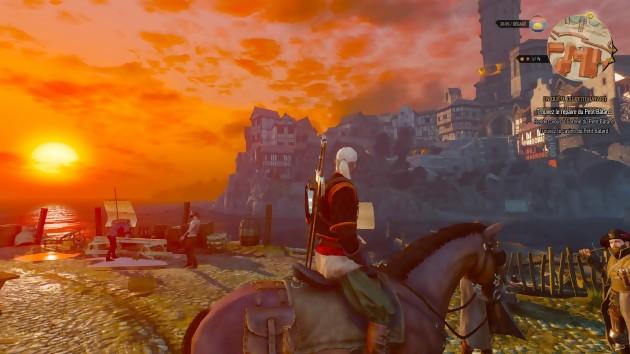 The narrative framework offered by this great beat through the Northern Kingdoms is therefore very conducive to the justification of a real open world, of which CD Projekt Red had already made the outline in the previous parts. The Polish studio uses its system of large open areas here but connects them together instead of having them follow one another over the course of the game. And of course, the whole thing takes on unprecedented proportions. The playing field becomes gigantic. You will cross the Strait of Velen, a wild area with a marshy tendency, in the heart of which nest the rich cities of Novigrad and Oxenfurt. True islands of civilization in the middle of brambles and bogs, but which remain equally dangerous places. You'll also sail to the Skellige Archipelago, steep snow-capped islands west of Temeria, populated by tribes of redheads with horned helmets. Pursuing Ciri will lead you to visit each of these areas. However, you are free to go there at any time and explore them as you see fit in order to appreciate the work that has been done on the open-world of the game. Because beyond their sizes, the maps of The Witcher 3 stands out for its variety and consistency, the activity that emanates from it and at the same time the feeling of loneliness that grips us as soon as we deviate from the beaten track.
The narrative framework offered by this great beat through the Northern Kingdoms is therefore very conducive to the justification of a real open world, of which CD Projekt Red had already made the outline in the previous parts. The Polish studio uses its system of large open areas here but connects them together instead of having them follow one another over the course of the game. And of course, the whole thing takes on unprecedented proportions. The playing field becomes gigantic. You will cross the Strait of Velen, a wild area with a marshy tendency, in the heart of which nest the rich cities of Novigrad and Oxenfurt. True islands of civilization in the middle of brambles and bogs, but which remain equally dangerous places. You'll also sail to the Skellige Archipelago, steep snow-capped islands west of Temeria, populated by tribes of redheads with horned helmets. Pursuing Ciri will lead you to visit each of these areas. However, you are free to go there at any time and explore them as you see fit in order to appreciate the work that has been done on the open-world of the game. Because beyond their sizes, the maps of The Witcher 3 stands out for its variety and consistency, the activity that emanates from it and at the same time the feeling of loneliness that grips us as soon as we deviate from the beaten track.
The Polish studio uses its system of large open areas here but connects them together instead of having them follow one another over the course of the game. And of course, the whole thing takes on unprecedented proportions. The playing field becomes gigantic.
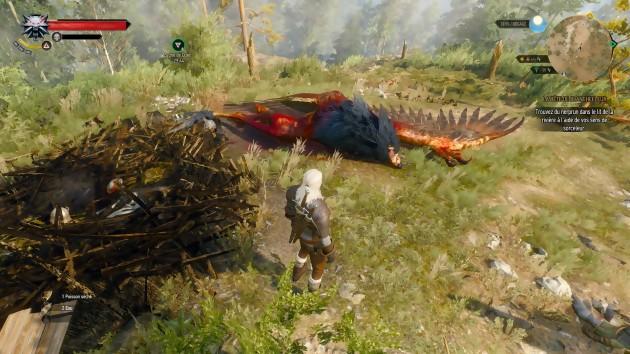 And that, we owe it first of all to the quality of the realization of the environments, in particular the wild areas, simply breathtaking. We do not count the number of places where we stopped simply to be able to contemplate a panorama or a sunset. The game is full of picture-postcard views, but also darker, creepier, dirtier, yet equally captivating locations. It's hard to know where to start when it comes to explaining the quality of this artistic direction and this level design: the density and realism of the vegetation, which moves with the wind? Climate changes, like that sky streaked by a violent storm in the night while riding on a ridge? The play of light offered by a setting sun or a torch on a stone wall? The fantastic rendering of bodies of water? The sense of detail, the animations of the wild life but also of the NPCs who lead their little life without giving a damn about your adventure? Everything is subject to an almost hypnotic contemplation. From this dirty fantasy world emerges a powerful feeling of melancholy, even unease, a feeling of end of reign largely supported by a soundtrack once again very successful.
And that, we owe it first of all to the quality of the realization of the environments, in particular the wild areas, simply breathtaking. We do not count the number of places where we stopped simply to be able to contemplate a panorama or a sunset. The game is full of picture-postcard views, but also darker, creepier, dirtier, yet equally captivating locations. It's hard to know where to start when it comes to explaining the quality of this artistic direction and this level design: the density and realism of the vegetation, which moves with the wind? Climate changes, like that sky streaked by a violent storm in the night while riding on a ridge? The play of light offered by a setting sun or a torch on a stone wall? The fantastic rendering of bodies of water? The sense of detail, the animations of the wild life but also of the NPCs who lead their little life without giving a damn about your adventure? Everything is subject to an almost hypnotic contemplation. From this dirty fantasy world emerges a powerful feeling of melancholy, even unease, a feeling of end of reign largely supported by a soundtrack once again very successful.
FANTASY STAR OFFLINE
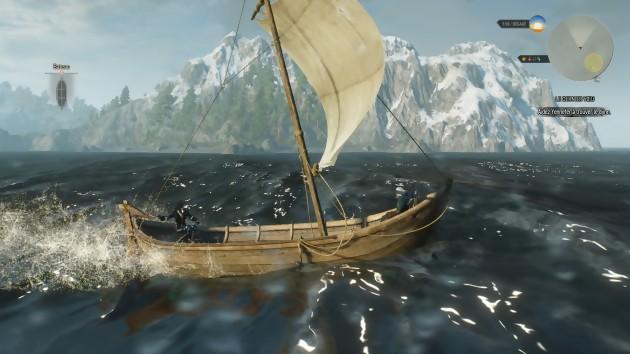 It is not, however, a mere empty shell. In fact, the title of CD Projekt Red gives you the opportunity to go absolutely anywhere on the map offered to you, on horseback, on foot or by boat. Don't get us wrong: this isn't just a movie set for your various quests. Your environment is literally riddled with villages of which you can visit almost every little house, caves, magical sites, nests of monsters to knock out, treasures guarded by dangerous creatures, bandit camps (which sometimes hold merchants or craftsmen hostage), smugglers' caches... All this with an overall amazing consistency: merchants, for example, do not sell all their items at the same price, they have their own nest egg and cannot buy your stock ad infinitum. The game world teems with life, activity and inspires you to explore from the first glance on the map. Be careful though: you are free to venture where you want, with the risks that this includes. This world is dangerous and you may very well come across an opponent stronger than you during your wanderings. But CD Projekt Red thought of leaving a safeguard: as for your various quests, each enemy encountered sees its level displayed and you will quickly know via a simple color code if it is within your reach or if it is better run off to better come back later. However, if you prepare your offensive correctly, it is quite possible to overcome enemies and missions that are theoretically too difficult.
It is not, however, a mere empty shell. In fact, the title of CD Projekt Red gives you the opportunity to go absolutely anywhere on the map offered to you, on horseback, on foot or by boat. Don't get us wrong: this isn't just a movie set for your various quests. Your environment is literally riddled with villages of which you can visit almost every little house, caves, magical sites, nests of monsters to knock out, treasures guarded by dangerous creatures, bandit camps (which sometimes hold merchants or craftsmen hostage), smugglers' caches... All this with an overall amazing consistency: merchants, for example, do not sell all their items at the same price, they have their own nest egg and cannot buy your stock ad infinitum. The game world teems with life, activity and inspires you to explore from the first glance on the map. Be careful though: you are free to venture where you want, with the risks that this includes. This world is dangerous and you may very well come across an opponent stronger than you during your wanderings. But CD Projekt Red thought of leaving a safeguard: as for your various quests, each enemy encountered sees its level displayed and you will quickly know via a simple color code if it is within your reach or if it is better run off to better come back later. However, if you prepare your offensive correctly, it is quite possible to overcome enemies and missions that are theoretically too difficult. The script context of Ciri's search and Geralt's (almost) regained freedom, as well as the setting up of this open world, is also the perfect opportunity for CD Projekt Red to finally be able to bring the player to life. the daily life of a witcher. And this is reflected in several ways in the game. The first is the great freedom that is left in the hierarchy of quests. You can very well ignore the common thread of the story to devote yourself to your professional activity: do your little grub, harvest plants, collect the contracts available on the notice boards of the various towns visited, collect your gold and go have brand new armor forged at the local blacksmith. In terms of gameplay, as we said in the preview, Geralt can now use his mutated witcher senses to gain immediate insight into interesting things around him: containers, important objects, or footprints. . He then engages in an investigator's approach, involving the collection of testimonies, the inspection of the scene of the crime or even a corpse, his explanations aloud serving to guide the player. The pattern of these contracts may seem repetitive, but the variety of situations to be faced and the quality of the writing of the quests manage to keep the player awake.
The script context of Ciri's search and Geralt's (almost) regained freedom, as well as the setting up of this open world, is also the perfect opportunity for CD Projekt Red to finally be able to bring the player to life. the daily life of a witcher. And this is reflected in several ways in the game. The first is the great freedom that is left in the hierarchy of quests. You can very well ignore the common thread of the story to devote yourself to your professional activity: do your little grub, harvest plants, collect the contracts available on the notice boards of the various towns visited, collect your gold and go have brand new armor forged at the local blacksmith. In terms of gameplay, as we said in the preview, Geralt can now use his mutated witcher senses to gain immediate insight into interesting things around him: containers, important objects, or footprints. . He then engages in an investigator's approach, involving the collection of testimonies, the inspection of the scene of the crime or even a corpse, his explanations aloud serving to guide the player. The pattern of these contracts may seem repetitive, but the variety of situations to be faced and the quality of the writing of the quests manage to keep the player awake.
WHAT ARE YOU DOING FOR THE NEXT THREE YEARS?
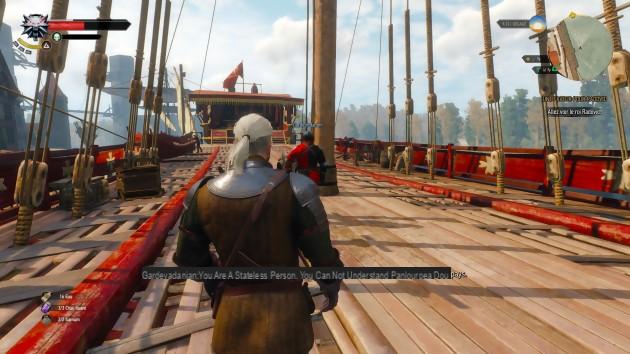 Besides, contracts are far from the only side quests that will come your way. You will also be able to hunt for treasure following the discovery of a map or a smugglers' cache, but also engage in bare-handed combat (with completely revised gameplay modeled on that of sword fighting), in horse racing (not exactly thrilling) or in gwent, a card game that replaces dice and which has the merit of being a real game within the game. However, the heart of the side quests is in the so-called secondary quests, events parallel to the main story, very often triggered by your progress within it and which have a link, an impact on the adventure. These secondary quests are astonishing by their thickness, their complexity, the involvement in the writing and by the repercussions they can have on the progress of the game. A decision taken at a given moment can have a consequence (going as far as the death of a character) a few hours later. Yes, you will have to make decisions, through the dialogue system, slightly offended. The branches are much more frequent and it is much more difficult to detect a "good" solution, to anticipate the impact of a declaration. It is also the charm and the strength of the game which succeeds even more than its predecessors in remaining in nuance, with the result of real great moments. On this, CD Projekt did not lie to us and encourages us not to ignore the slightest quest, just to take advantage of the whole experience. And we can guarantee you a completely gargantuan lifespan as a result: after more than 70 or 80 hours of play, we were far from seeing the end of it!
Besides, contracts are far from the only side quests that will come your way. You will also be able to hunt for treasure following the discovery of a map or a smugglers' cache, but also engage in bare-handed combat (with completely revised gameplay modeled on that of sword fighting), in horse racing (not exactly thrilling) or in gwent, a card game that replaces dice and which has the merit of being a real game within the game. However, the heart of the side quests is in the so-called secondary quests, events parallel to the main story, very often triggered by your progress within it and which have a link, an impact on the adventure. These secondary quests are astonishing by their thickness, their complexity, the involvement in the writing and by the repercussions they can have on the progress of the game. A decision taken at a given moment can have a consequence (going as far as the death of a character) a few hours later. Yes, you will have to make decisions, through the dialogue system, slightly offended. The branches are much more frequent and it is much more difficult to detect a "good" solution, to anticipate the impact of a declaration. It is also the charm and the strength of the game which succeeds even more than its predecessors in remaining in nuance, with the result of real great moments. On this, CD Projekt did not lie to us and encourages us not to ignore the slightest quest, just to take advantage of the whole experience. And we can guarantee you a completely gargantuan lifespan as a result: after more than 70 or 80 hours of play, we were far from seeing the end of it!
The incentive to discover is also a bit of the guideline of the title, which also leaves you the choice of the narration. The world in which Geralt evolves is not imposed on you, you will have to go find it.
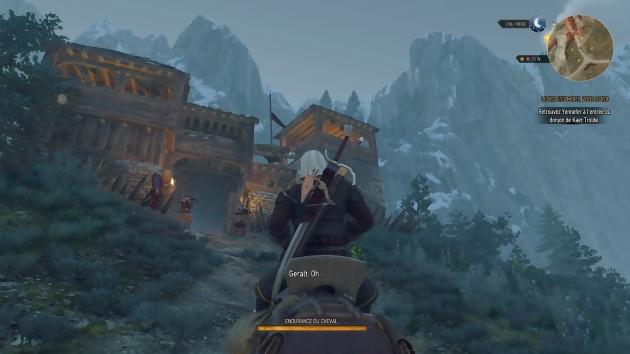 The incentive to discover is also a bit of the guideline of the title, which also leaves you the choice of the narration. The world in which Geralt evolves is not imposed on you, you will have to go find it. In the dialogues first, taking the time to talk with as many NPCs as possible, also choosing to ask questions that are not necessarily essential to get more information. But it also goes through the books that you are completely free to glean, buy and then read to fill in the gaps in a deliberately elliptical story. The game's internal encyclopedia will give you more precise data on the monsters or characters encountered. Because once again, the universe of the Witcher wants to be particularly substantial, deep. His recurring themes such as alcohol, racism, religion or even the relationship to all sexualities are treated with more or less success. But their presence is still one of the pillars of the game. Speaking of sexuality, note also that Geralt's libido has been considerably curbed. And if the sex scenes are always there, they are limited in number and expressiveness. Besides, while it's easy to see this as a degradation of the status of women in the game, that would overshadow the fact that the developers have tried to deepen Geralt's various relationships. And above all, it would be to forget that the balance of power with the Witcher is often to his disadvantage: each time it is a strong, intelligent woman, who will use Geralt at his expense, thus rebalancing the image. which is his.
The incentive to discover is also a bit of the guideline of the title, which also leaves you the choice of the narration. The world in which Geralt evolves is not imposed on you, you will have to go find it. In the dialogues first, taking the time to talk with as many NPCs as possible, also choosing to ask questions that are not necessarily essential to get more information. But it also goes through the books that you are completely free to glean, buy and then read to fill in the gaps in a deliberately elliptical story. The game's internal encyclopedia will give you more precise data on the monsters or characters encountered. Because once again, the universe of the Witcher wants to be particularly substantial, deep. His recurring themes such as alcohol, racism, religion or even the relationship to all sexualities are treated with more or less success. But their presence is still one of the pillars of the game. Speaking of sexuality, note also that Geralt's libido has been considerably curbed. And if the sex scenes are always there, they are limited in number and expressiveness. Besides, while it's easy to see this as a degradation of the status of women in the game, that would overshadow the fact that the developers have tried to deepen Geralt's various relationships. And above all, it would be to forget that the balance of power with the Witcher is often to his disadvantage: each time it is a strong, intelligent woman, who will use Geralt at his expense, thus rebalancing the image. which is his.
Swimming and exploration of the seabed (hello GTA) are also appearing, with even the possibility of fighting with a crossbow under the surface of the water.
 On the handling side, The Witcher 3 continues the modernization started with the second opus, with some pitfalls from right to left. Geralt is much less rigid than before, he can step over barriers, he adapts his pace indoors (which prevents you from eating the walls half the time) and gains in passing a jump command and another sprint command ( which obviously depletes your Stamina gauge). A must for the transition to an open world which is also much more vertical. Too bad, however, that the White Wolf lost at the same time the script which allowed him to descend from a ledge without farting miserably the mouth. You will now have to look for the lowest place and attempt a jump, hoping to lose as little life as possible... Swimming and exploring the seabed (hello GTA) are also appearing, with even the possibility to fight with a crossbow under the surface of the water. Don't ask me how it's possible, it's part of the game's deep mysteries, like the fact that NPCs don't put up any resistance to your systematic looting of their barracks or the day/night cycle not really set on time real. But let's move on. Geralt's freedom of movement also means boats, which can be damaged if you hit a rock or are attacked. Or his nag, Roach, which allows him to cross the country without wearing out the soles of his boots but also to wear more equipment. A blessing in disguise, the mare sometimes having a tendency to behave very strangely.
On the handling side, The Witcher 3 continues the modernization started with the second opus, with some pitfalls from right to left. Geralt is much less rigid than before, he can step over barriers, he adapts his pace indoors (which prevents you from eating the walls half the time) and gains in passing a jump command and another sprint command ( which obviously depletes your Stamina gauge). A must for the transition to an open world which is also much more vertical. Too bad, however, that the White Wolf lost at the same time the script which allowed him to descend from a ledge without farting miserably the mouth. You will now have to look for the lowest place and attempt a jump, hoping to lose as little life as possible... Swimming and exploring the seabed (hello GTA) are also appearing, with even the possibility to fight with a crossbow under the surface of the water. Don't ask me how it's possible, it's part of the game's deep mysteries, like the fact that NPCs don't put up any resistance to your systematic looting of their barracks or the day/night cycle not really set on time real. But let's move on. Geralt's freedom of movement also means boats, which can be damaged if you hit a rock or are attacked. Or his nag, Roach, which allows him to cross the country without wearing out the soles of his boots but also to wear more equipment. A blessing in disguise, the mare sometimes having a tendency to behave very strangely.
A HUNTING WITCHER
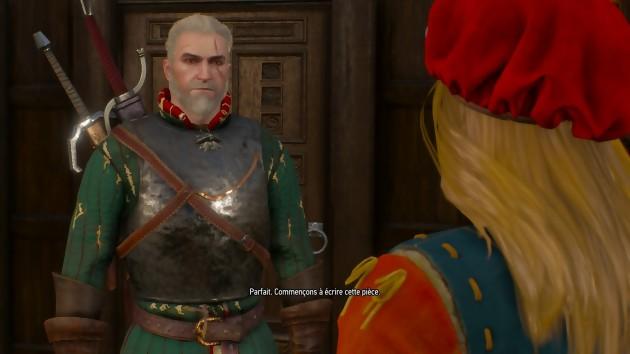 Unsurprisingly, the combat system is directly affected by this desire for flexibility in the maneuverability of the hero. CD Projekt took most of what made the second game progress, namely a more classic and more nervous A-RPG gameplay, and optimized it. Exit the QTEs! We find the trio quick blow, powerful blow and Signs (the use of which passes on a trigger), palette that we will have to chain as best we can while keeping an eye on the Vigor gauge. While it is still possible to avoid a hit with a roll, Geralt can now perform a shorter, more subtle dodge to stay in contact. In the same spirit, the counter-attack system, which consists in parrying just before attacking one, does not make it possible to kill the opponent instantly but rather to open a window for the offensive. This notion is at the very center of the combat system of The Witcher 3: often, rushing to attack blindly is synonymous with certain death. You will first have to prepare for the confrontation, potash the bestiary, target the opponent's weaknesses, sometimes develop an oil (the reloading of potions is now done during meditation if you have enough to lengthen a pre-existing mixture). Then once in the heat of the action, it will be a question of dodging for the monsters, of counter-attacking for the humans and of carrying out a blow or two, no more, before seeing a new window open. thrust and possibly trigger a bloody finish move based on dismemberment or decapitation. Groups of enemies, even weak ones, turn out to be particularly dangerous and you will have to be patient, try to split them using Signs and use the environment (ignite the gases in the swamps, for example) so as not to lose your skin! The problem becomes more complex during indoor fights, the fault of a somewhat crappy camera and a lock system (which incidentally disappears without explanation against the bosses).
Unsurprisingly, the combat system is directly affected by this desire for flexibility in the maneuverability of the hero. CD Projekt took most of what made the second game progress, namely a more classic and more nervous A-RPG gameplay, and optimized it. Exit the QTEs! We find the trio quick blow, powerful blow and Signs (the use of which passes on a trigger), palette that we will have to chain as best we can while keeping an eye on the Vigor gauge. While it is still possible to avoid a hit with a roll, Geralt can now perform a shorter, more subtle dodge to stay in contact. In the same spirit, the counter-attack system, which consists in parrying just before attacking one, does not make it possible to kill the opponent instantly but rather to open a window for the offensive. This notion is at the very center of the combat system of The Witcher 3: often, rushing to attack blindly is synonymous with certain death. You will first have to prepare for the confrontation, potash the bestiary, target the opponent's weaknesses, sometimes develop an oil (the reloading of potions is now done during meditation if you have enough to lengthen a pre-existing mixture). Then once in the heat of the action, it will be a question of dodging for the monsters, of counter-attacking for the humans and of carrying out a blow or two, no more, before seeing a new window open. thrust and possibly trigger a bloody finish move based on dismemberment or decapitation. Groups of enemies, even weak ones, turn out to be particularly dangerous and you will have to be patient, try to split them using Signs and use the environment (ignite the gases in the swamps, for example) so as not to lose your skin! The problem becomes more complex during indoor fights, the fault of a somewhat crappy camera and a lock system (which incidentally disappears without explanation against the bosses).
Without going as far as a specific specification of Geralt's stats, this third installment, however, offers a much more interesting RPG approach than its two predecessors.
 Without going as far as a specific specification of Geralt's stats, this third installment, however, offers a much more interesting RPG approach than its two predecessors. Indeed, the modification of the profile of our friend has been completely revised in order to really orient the qualities of your witcher. With each skill point obtained (by gaining a level but also by activating a magic site), you can gain a new skill or improve an already learned one. But not all of them can be activated at the same time! You will therefore have to choose what you want to prioritize, with a limited number of slots. On the other hand, the mutagens harvested from the corpses of monsters can now be used either to simmer a decoction with very special abilities, a sort of temporary super potion; or to constantly improve Geralt's abilities. Knowing that aligning mutagens and abilities of the same type (combat, magic, potions) will give you statistical bonuses! Also be aware that farming the drowner will not make you progress more than that, finishing quests being the real only vector of progress. Incidentally, all the menus have been given a big facelift. The world map is finally detailed. We forget the five-year-old child's drawings that served as a map in The Witcher 2. We can put marks on them, filter according to what we want to see appear, in short, the basis for an open world in 2015, but it was not necessarily won. Only downside, the lack of possibility to focus on the next objective: given the size of the maps, it would have been useful. The inventory also gains in readability and we can finally see in advance the quickdraw of Geralt according to the equipment that we give him. A detail yes, but it's nice all the same. Always in the field of detail: the weight of the equipment has been rebalanced and we no longer carry around ALL the diagrams we pick up. Each schematic will now nicely spawn the corresponding item/potion in the Alchemy or Crafting category.
Without going as far as a specific specification of Geralt's stats, this third installment, however, offers a much more interesting RPG approach than its two predecessors. Indeed, the modification of the profile of our friend has been completely revised in order to really orient the qualities of your witcher. With each skill point obtained (by gaining a level but also by activating a magic site), you can gain a new skill or improve an already learned one. But not all of them can be activated at the same time! You will therefore have to choose what you want to prioritize, with a limited number of slots. On the other hand, the mutagens harvested from the corpses of monsters can now be used either to simmer a decoction with very special abilities, a sort of temporary super potion; or to constantly improve Geralt's abilities. Knowing that aligning mutagens and abilities of the same type (combat, magic, potions) will give you statistical bonuses! Also be aware that farming the drowner will not make you progress more than that, finishing quests being the real only vector of progress. Incidentally, all the menus have been given a big facelift. The world map is finally detailed. We forget the five-year-old child's drawings that served as a map in The Witcher 2. We can put marks on them, filter according to what we want to see appear, in short, the basis for an open world in 2015, but it was not necessarily won. Only downside, the lack of possibility to focus on the next objective: given the size of the maps, it would have been useful. The inventory also gains in readability and we can finally see in advance the quickdraw of Geralt according to the equipment that we give him. A detail yes, but it's nice all the same. Always in the field of detail: the weight of the equipment has been rebalanced and we no longer carry around ALL the diagrams we pick up. Each schematic will now nicely spawn the corresponding item/potion in the Alchemy or Crafting category.
MY BELOVED SORCERER
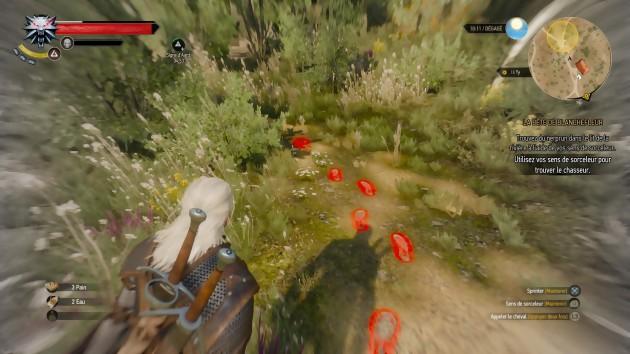 In the end, the biggest criticisms that can be made to The Witcher 3 are technical. The PS4 version that we were given to try suffered from a sluggish framerate, clear proof that the game is clearly pushing the console to its limits. Collisions are often rough (which, admittedly, is fairly endemic to open-world titles) and pathfinding your pony will surely make you laugh every time you whistle it. Clipping also wreaks havoc on textures, even on some NPCs that pop out of nowhere, and the display distance, less good than advertised, hides behind a strict artistic blur. The cities are also quite empty and we feel that the developers did not want to 1) pull too much on the console's oar or 2) see too many clones wandering the streets. To complete the picture, the loadings which follow the death of the hero are unbearably long and we deplore the lack of ambition of the cut-scenes which will sometimes prefer fades to black to save themselves an overly complicated transition. BUT (and you will have noticed, it's really a big but), the game is nonetheless superb. The artistic direction is still as effective as ever (see above). The textures of the clothes and the faces, just like the lip sync and the quality of the VO and VF, reinforce the credibility of the characters and the effort of direction, limited but valid, makes the dialogues much more digestible.
In the end, the biggest criticisms that can be made to The Witcher 3 are technical. The PS4 version that we were given to try suffered from a sluggish framerate, clear proof that the game is clearly pushing the console to its limits. Collisions are often rough (which, admittedly, is fairly endemic to open-world titles) and pathfinding your pony will surely make you laugh every time you whistle it. Clipping also wreaks havoc on textures, even on some NPCs that pop out of nowhere, and the display distance, less good than advertised, hides behind a strict artistic blur. The cities are also quite empty and we feel that the developers did not want to 1) pull too much on the console's oar or 2) see too many clones wandering the streets. To complete the picture, the loadings which follow the death of the hero are unbearably long and we deplore the lack of ambition of the cut-scenes which will sometimes prefer fades to black to save themselves an overly complicated transition. BUT (and you will have noticed, it's really a big but), the game is nonetheless superb. The artistic direction is still as effective as ever (see above). The textures of the clothes and the faces, just like the lip sync and the quality of the VO and VF, reinforce the credibility of the characters and the effort of direction, limited but valid, makes the dialogues much more digestible.


























